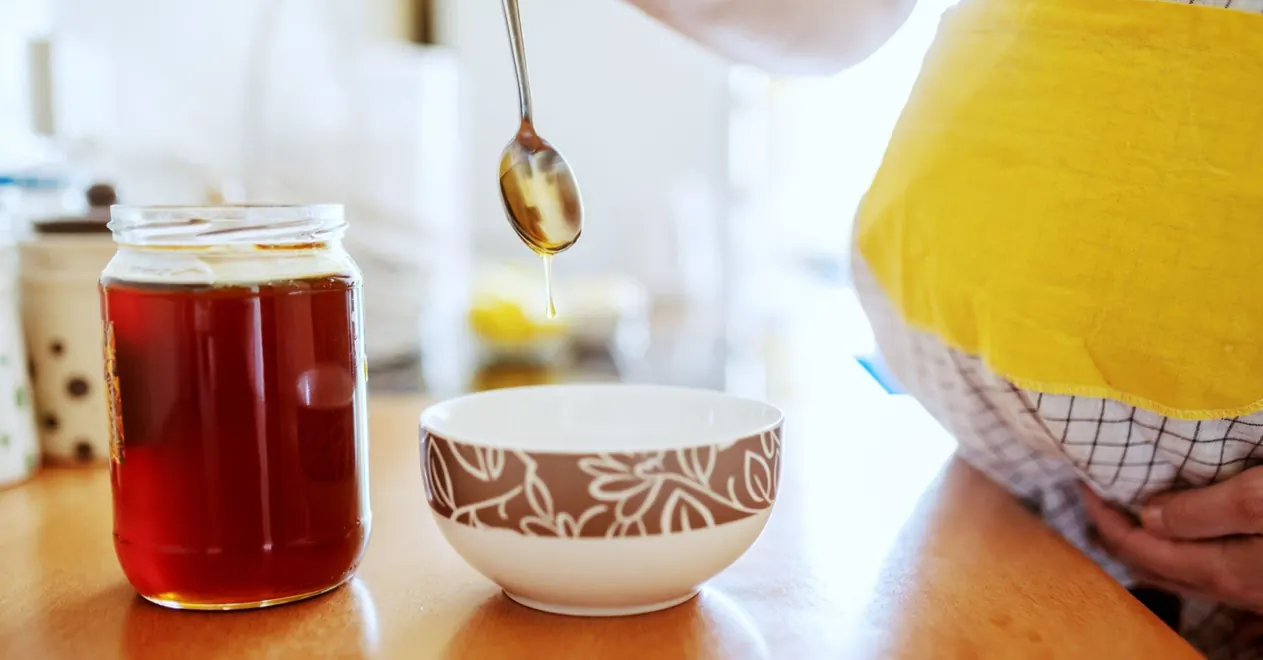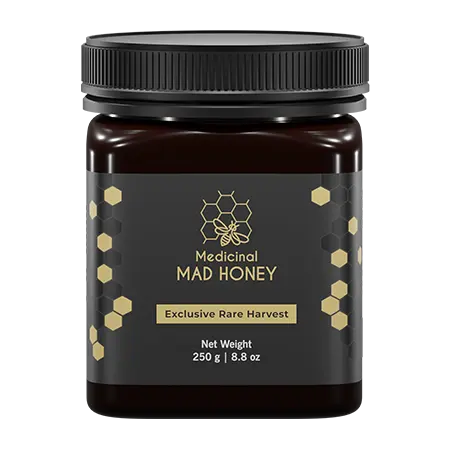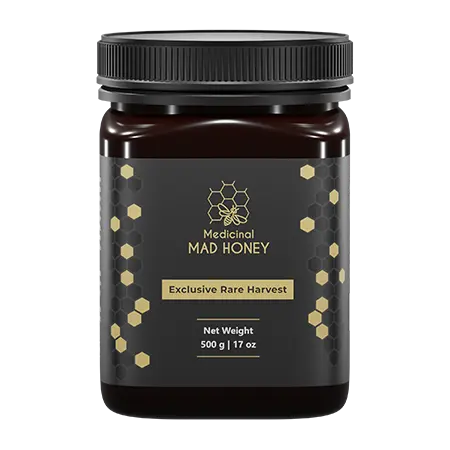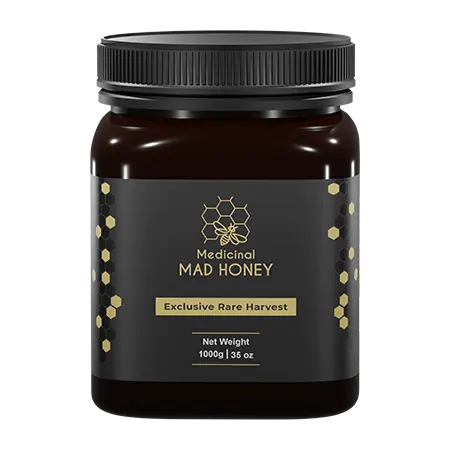
Whether you are a newbie mother-to-be or have already given birth to multiple babies, you are always keen to choose the best for yourself and your baby. But often, this interest leads to confusion and frustration.
The same dilemma might arise when you try to understand if the infamous mad honey is safe for your child. So here’s to knowing what’s best.
Mad Honey
Mad honey is a rare kind of honey that is found in the mountains of the Lamjung district. The giant honeybees collect the honey from the nectar of rhododendron flowers. From the process to the effects of mad honey, everything is unique.
Although mad honey has recently gained popularity, the honey hunters’ community has been using it for a very long time—let’s say thousands of years. They not only sold the mad honey but also consumed it.
Mad Honey Benefits
Mad honey offers a range of intriguing benefits. Firstly, it contains grayanotoxins, which have been traditionally used for pain relief.
Additionally, it serves as a digestive aid, soothing issues such as indigestion and gastritis, effectively regulating the digestive system, and alleviating symptoms like bloating and heartburn.
Furthermore, mad honey serves as a natural energy booster thanks to its high sugar content, making it an excellent choice for quick replenishment of energy levels, especially for athletes and hikers.
Like many other honey varieties, mad honey boasts antioxidants that combat free radicals in the body. This antioxidant power can slow down the aging process and reduce the risk of chronic diseases.
Moreover, this honey has been used topically for wound healing due to its antibacterial properties, which prevent infection, while its natural sugars promote tissue repair.
For those with respiratory issues such as asthma and bronchitis, mad honey may offer relief. Its anti-inflammatory properties can help reduce airway inflammation.
Some cultures even believe that mad honey enhances cognitive function and memory, potentially attributed to its grayanotoxins, which may have a mild nootropic effect.
Lastly, consuming small amounts of mad honey may contribute to improved heart health by lowering bad cholesterol levels and reducing the risk of cardiovascular diseases.
Can You Eat Mad Honey When Pregnant?
Unfortunately, you cannot consume mad honey while pregnant because of its grayanotoxin content. The neurotoxin might interfere with pregnancy hormones. Therefore, it’s best to avoid mad honey consumption to be on the safer side.
Also, it is advisable not to consume mad honey of any kind while you are breastfeeding your baby. Wait a few months or years before you can finally consume it.
If your children are still growing and have not hit adulthood, make sure they don’t eat honey. Even if you are consuming it, keep it out of children’s reach and make them aware of its side effects.
Alternative Choices for Women During Pregnancy
Craving during pregnancy is normal! If you are craving some sweet-like food and want it to be healthier, you can still consume the following sweeteners that are alternatives to mad honey:
Jaggery: Jaggery’s mineral content makes it a healthier option for individuals aiming to cut down on the empty calories found in brown or white sugar.
It offers a natural source of iron, which helps prevent or ease iron deficiency anemia during pregnancy. Jaggery is also packed with essential minerals like calcium and potassium, which contribute to the development of the baby’s bones and muscles.
Additionally, its natural sweetness can be a satisfying way to curb pregnancy cravings without the excess sugars commonly found in processed sweets. This makes it a healthier choice for maintaining a balanced diet during this critical period of pregnancy
Maple Syrup: Pure maple syrup is an excellent natural sweetener rich in antioxidants, vitamins, and minerals. Ensure that you select 100% pure maple syrup without added sugars or artificial ingredients.
Stevia: Stevia is a calorie-free sweetener derived from the leaves of the Stevia rebaudiana plant. It has a negligible impact on blood sugar levels and can be a suitable choice for pregnant women with gestational diabetes.
Agave Nectar: Agave nectar is derived from the agave plant and is sweeter than sugar, so you can use less of it. It has a low glycemic index and may help stabilize blood sugar levels.
Coconut Sugar: Coconut sugar is made from the sap of coconut palm trees and contains vitamins and minerals. It has a lower glycemic index than regular sugar.
Molasses: Molasses, especially blackstrap molasses, is a nutrient-rich sweetener. It’s a good source of iron, calcium, and potassium.
Mad Honey Dosage
- For adults between the ages of 18 and 35, 1 to 2 tablespoons, depending on your preference and tolerance,
- For adults above 35, only 1 tablespoon
- For children, no amount of mad honey should be given.
Mad Honey Precautions
While mad honey can offer potential health benefits, it’s crucial to exercise caution when considering its consumption due to the presence of grayanotoxins, which can be toxic in high amounts.
Here are some precautions to keep in mind:
Limit to Recommended Dosage: Often, people become enthusiasts of the results, and they want the outcome to be faster and amplified. But it’s essential to understand that moderation is the key.
Only consume small amounts of mad honey at a time. Excessive intake can lead to serious health issues, including dizziness, nausea, vomiting, and even heart problems.
Consult a Healthcare Professional: Before incorporating mad honey into your diet or using it for medicinal purposes, consult with a healthcare professional. They can provide guidance on safe consumption and assess whether it’s appropriate for your individual health circumstances.
Know the source: Ensure you obtain mad honey from a reputable source. Honey collected from certain types of rhododendron or other toxic plants can contain higher levels of grayanotoxins, making it more dangerous. Buy from trusted beekeepers or suppliers.
Avoid It During Pregnancy: Pregnant women should avoid mad honey altogether. The grayanotoxins can have adverse effects on the developing fetus and should not be consumed during pregnancy. Be
Cautious with Children: Children are more vulnerable to the toxic effects of mad honey. It’s best to avoid giving mad honey to young children altogether to prevent any potential harm.
Be Mindful of Existing Health Conditions: If you have pre-existing health conditions, especially heart-related issues, it’s essential to be cautious. Grayanotoxins can lower blood pressure and potentially lead to irregular heart rhythms.
Don’t Drive or Operate Machinery: Due to the potential dizziness and other side effects associated with excessive mad honey consumption, it’s advisable to avoid driving or operating heavy machinery after ingesting it.
Educate yourself: Educate yourself about the symptoms of mad honey poisoning. Early recognition of symptoms such as dizziness, nausea, and weakness is crucial for seeking prompt medical attention if needed.
Final Thought
A woman’s pregnancy is a significant and transformative time in her life, with numerous physical and emotional changes. One crucial aspect of a healthy pregnancy is making informed dietary choices.
The foods a pregnant woman consumes can directly impact her health and the development of her growing baby. Thus, it becomes essential to carefully consider the safety and nutritional value of everything that enters her body during this time.
You can also opt for alternatives to mad honey to satisfy your craving! Enjoy the time with your baby and pregnancy.





